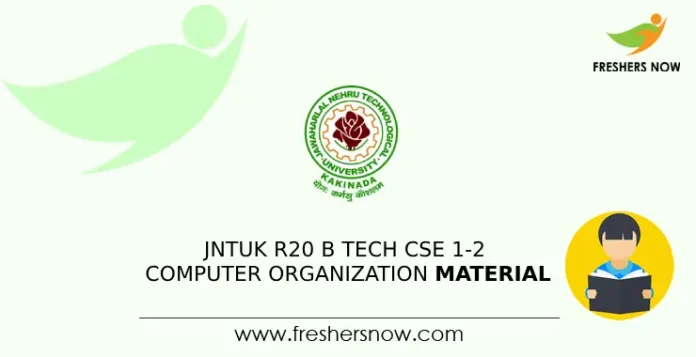
JNTUK R20 B Tech CSE 1-2 Computer Organization Material/ Notes PDF Download: Discover the essentials of computer organization with our JNTUK R20 B Tech CSE 1-2 Computer Organization Material. This course is crafted to introduce you to the core principles and basic architectural concepts, providing a deep dive into the fundamental organization, design, and programming of a simple digital computer. Explore key topics such as computer arithmetic, instruction set design, microprogrammed control unit, pipelining, vector processing, memory organization, and I/O systems.
Our material serves as a valuable guide for students aiming to grasp the foundational aspects of computer organization. Access this wealth of knowledge effortlessly by downloading the JNTUK R20 B Tech CSE 1-2 Computer Organization Material PDF. Stay ahead in your studies and build a solid understanding of computer organization concepts.
JNTUK R20 B Tech CSE 1-2 Computer Organization Material – Units
| No. Of Units | Name of the Unit |
| Unit – 1 | Conceptual introduction, Data Representation, Combinational Circuits |
| Unit – 2 | Digital logic circuits, Sequential Switching Circuits |
| Unit – 3 | Computer Arithmetic, Basic Computer Organization and Design |
| Unit – 4 | Micro programmed Control, Central Processing Unit, 8086 microprocessor |
| Unit – 5 | Memory Organization, Input-Output Organization |
Unit 1 Syllabus PDF Download | JNTUK R20 B Tech CSE Computer Organization Material
Conceptual introduction: topics in computer science, algorithms; modern computer Digital Components and Data Representation: Introduction, Numbering Systems, Decimal to Binary Conversion, Binary Coded Decimal Numbers, Weighted Codes, Self-Complementing Codes, Cyclic Codes, Error Detecting Codes, Error Correcting Codes, Hamming Code for Error Correction, Alphanumeric Codes, ASCII Code
Data Representation: Data types, Complements, Fixed Point Representation, Floating Point Representation.
Combinational Circuits: Boolean expressions and their minimization using algebraic identities; Karnaugh map representation and minimization of Boolean functions using Kmap; Two-level realizations using gates — AND-OR, OR-AND, NAND-NAND and NORNOR structures
| JNTUK R20 B Tech CSE 1-2 Computer Organization Material – PDF Download | |
| To Download The JNTUK R20 B Tech CSE 1-2 Computer Organization Unit 1 Notes | Download Reference 1 | Download Reference 2 |
Unit 2 Syllabus PDF Download | JNTUK R20 B Tech CSE Computer Organization Material
Digital logic circuits: Combinatorial Circuits: Introduction, Combinatorial Circuit Design Procedure, Integrated NAND-NOR Gates, Multifunction gates, Multi-bit adder, Multiplexers, De-multiplexers, Decoders
Sequential Switching Circuits: Latches and Flip-Flops, Ripple counters using T flipflops; Synchronous counters; Shift Registers; Ring counters
| JNTUK R20 B Tech CSE 1-2 Computer Organization Material – PDF Download | |
| To Download The JNTUK R20 B Tech CSE 1-2 Computer Organization Unit 2 Notes | Download PDF |
Unit 3 Syllabus PDF Download | JNTUK R20 B Tech CSE Computer Organization Material
Computer Arithmetic: Addition and subtraction, multiplication Algorithms, Division Algorithms, Floating–point Arithmetic operations. Decimal Arithmetic unit, Decimal Arithmetic operations.
Basic Computer Organization and Design: Instruction codes, Computer Registers Computer instructions, Timing and Control, Instruction cycle, Memory Reference Instructions, Input–Output, and Interrupt.
| JNTUK R20 B Tech CSE 1-2 Computer Organization Material – PDF Download | |
| To Download The JNTUK R20 B Tech CSE 1-2 Computer Organization Unit 3 Notes | Download Reference 1 | Download Reference 2 | Download Reference 3 |
Unit 4 Syllabus PDF Download | JNTUK R20 B Tech CSE Computer Organization Material
Micro-programmed Control: Control memory, Address sequencing, microprogram example, design of control unit.
Central Processing Unit: General Register Organization, Instruction Formats, Addressing modes, Data Transfer and Manipulation, and Program Control.
8086 microprocessor: pin diagram, instruction set, Introduction to assembly language programming, Assembler, linker, Locator, debugger, emulator concepts. Assembler directives, 8086 programming examples to implement while – do, Repeat – Until, if-then-else constructs, etc, String operations, Array, far and near procedures, macros. Timing and delay loops
| JNTUK R20 B Tech CSE 1-2 Computer Organization Material – PDF Download | |
| To Download The JNTUK R20 B Tech CSE 1-2 Computer Organization Unit 4 Notes | Download Reference 1 | Download Reference 2 | Download Reference 3 |
Unit 5 Syllabus PDF Download | JNTUK R20 B Tech CSE Computer Organization Material
Memory Organization: Memory Hierarchy, Main Memory, Auxiliary Memory, Associate Memory, Cache Memory.
Input-Output Organization: Input-Output Interface, Asynchronous data transfer, Modes of Transfer, Priority Interrupt Direct Memory Access.
| JNTUK R20 B Tech CSE 1-2 Computer Organization Material – PDF Download | |
| To Download The JNTUK R20 B Tech CSE 1-2 Computer Organization Unit 5 Notes | Download Reference 1 | Download Reference 2 |
For more details about JNTUK R20 B Tech CSE 1-2 Computer Organization Material and other materials follow our official website Freshersnow.com.
JNTUK R20 B Tech Computer Organization Material – Outcomes
- Digital System Design: Understand the functional unit design of digital computer systems.
- Boolean Algebra and Combinational Functions: Relate Boolean algebra postulates to minimize combinational functions.
- Number Representation: Recognize and manipulate numbers stored in digital computers.
- Logic Gates and Families: Build logic families and implement logic gates for digital circuits.
- Circuit Design: Design and analyze both combinational and sequential circuits.
- Computer Components and Functions: Identify and assess issues in ISA, memory, control, and I/O functions.
- Internal Computer Organization: Recall the internal organization of computers, including CPU, memory, and Input/Output.
- Assembly Language Problem Solving: Solve elementary problems through assembly language programming, demonstrating practical programming skills.



